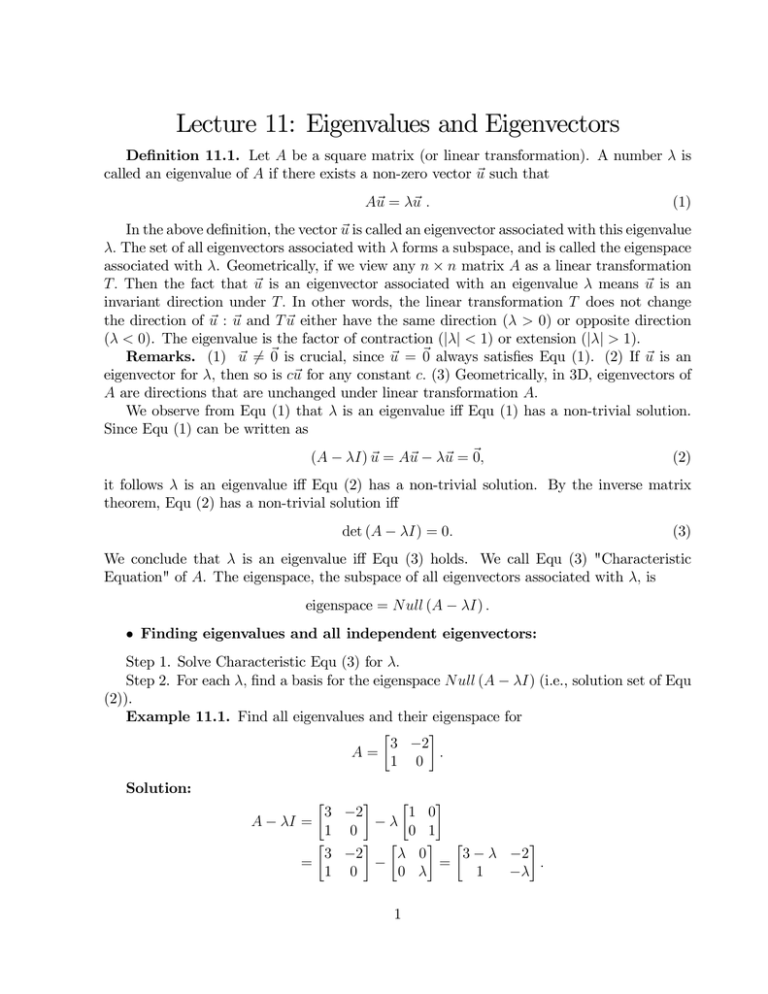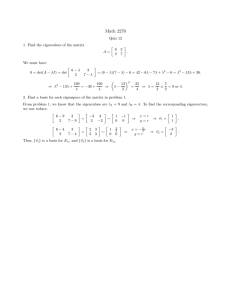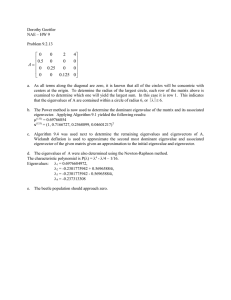Lecture 11: Eigenvalues and Eigenvectors
advertisement

Lecture 11: Eigenvalues and Eigenvectors De…nition 11.1. Let A be a square matrix (or linear transformation). A number ¸ is called an eigenvalue of A if there exists a non-zero vector ~u such that A~u = ¸~u : (1) In the above de…nition, the vector ~u is called an eigenvector associated with this eigenvalue ¸: The set of all eigenvectors associated with ¸forms a subspace, and is called the eigenspace associated with ¸. Geometrically, if we view any n £ n matrix A as a linear transformation T: Then the fact that ~u is an eigenvector associated with an eigenvalue ¸ means ~u is an invariant direction under T: In other words, the linear transformation T does not change the direction of ~u : ~u and T ~u either have the same direction (¸ > 0) or opposite direction (¸< 0). The eigenvalue is the factor of contraction (j¸j < 1) or extension (j¸j > 1). Remarks. (1) ~u 6= ~0 is crucial, since ~u = ~0 always satis…es Equ (1). (2) If ~u is an eigenvector for ¸; then so is c~u for any constant c: (3) Geometrically, in 3D, eigenvectors of A are directions that are unchanged under linear transformation A: We observe from Equ (1) that ¸ is an eigenvalue i¤ Equ (1) has a non-trivial solution. Since Equ (1) can be written as (A ¡ ¸I) ~u = A~u ¡ ¸~u = ~0; (2) it follows ¸ is an eigenvalue i¤ Equ (2) has a non-trivial solution. By the inverse matrix theorem, Equ (2) has a non-trivial solution i¤ det (A ¡ ¸I) = 0: (3) We conclude that ¸ is an eigenvalue i¤ Equ (3) holds. We call Equ (3) "Characteristic Equation" of A. The eigenspace, the subspace of all eigenvectors associated with ¸; is eigenspace = Null (A ¡ ¸I) : ² Finding eigenvalues and all independent eigenvectors: Step 1. Solve Characteristic Equ (3) for ¸: Step 2. For each ¸; …nd a basis for the eigenspace Null (A ¡ ¸I) (i.e., solution set of Equ (2)). Example 11.1. Find all eigenvalues and their eigenspace for · ¸ 3 ¡2 A= : 1 0 Solution: · ¸ · ¸ 3 ¡2 1 0 A ¡ ¸I = ¡¸ 1 0 0 1 · ¸ · ¸ · ¸ 3 ¡2 ¸ 0 3 ¡ ¸ ¡2 = ¡ = : 1 0 0 ¸ 1 ¡¸ 1 The characteristic equation is det (A ¡ ¸I) = (3 ¡ ¸) (¡¸) ¡ (¡2) = 0; ¸2 ¡ 3¸+ 2 = 0; (¸¡ 1) (¸¡ 2) = 0: We …nd eigenvalues ¸1 = 1; ¸2 = 2: We next …nd eigenvectors associated with each eigenvalue. For ¸1 = 1; · ¸· ¸ · ¸· ¸ 3 ¡ 1 ¡2 x 2 ¡2 x1 1 ~0 = (A ¡ ¸1 I) ~x = = ; 1 ¡1 x2 1 ¡1 x2 or x1 = x2 : The parametric vector form of solution set for (A ¡ ¸1 I) ~x = ~0 : · ¸ · ¸ · ¸ x1 x2 1 ~x = = = x2 : x2 x2 1 · ¸ 1 basis of Null (A ¡ I) : : 1 This is only (linearly independent) eigenvector for ¸1 = 1: The last step can be done slightly di¤erently as follows. From solutions (for (A ¡ ¸1 I) ~x = ~0 ) x1 = x2 ; we know there is only one free variable x2 . Therefore, there is only one vector in any basis. To …nd it, we take x2 to be any nonzero number, for instance, x2 = 1; and compute x1 = x2 = 1: We obtain · ¸ · ¸ x 1 ¸1 = 1; ~u1 = 1 = : x2 1 For ¸2 = 2; we …nd or · ¸· ¸ · ¸· ¸ ~0 = (A ¡ ¸2 I) ~x = 3 ¡ 2 ¡2 x1 = 1 ¡2 x1 ; 1 ¡2 x2 1 ¡2 x2 x1 = 2x2 : To …nd a basis, we take x2 = 1: Then x1 = 2; and a pair of eigenvalue and eigenvector · ¸ 2 ¸2 = 2; ~u2 = : 1 2 Example 11.2. Given that 2 is an eigenvalue 2 4 ¡1 4 A= 2 1 2 ¡1 for 3 6 65 : 8 Find a basis of its eigenspace. Solution: 2 3 2 3 2 3 4 ¡ 2 ¡1 6 2 ¡1 6 2 ¡1 6 A ¡ 2I = 4 2 1¡2 6 5 = 42 ¡1 65 ! 40 0 05 : 2 ¡1 8 ¡ 2 2 ¡1 6 0 0 0 Therefore, (A ¡ 2I) ~x = ~0 becomes 2x1 ¡ x2 + 6x3 = 0; or x2 = 2x1 + 6x3 ; (4) where we select x1 and x3 as free variables only to avoid fractions. Solution set in parametric form is 2 3 2 3 2 3 2 3 x1 x1 1 0 ~x = 4x2 5 = 42x1 + 6x3 5 = x1 425 + x3 465 : x3 x3 0 1 A basis for the eigenspace: 2 3 2 3 1 0 4 5 4 ~ 1 = 2 and ~u2 = 65 : u 0 1 Another way of …nding a basis for Null (A ¡ ¸I) = Null (A ¡ 2I) may be a little easier. From Equ (4), we know that x1 an x3 are free variables. Choosing (x1 ; x3 ) = (1; 0) and (0; 1) ; respectively, we …nd 2 3 1 4 x1 = 1; x3 = 0 =) x2 = 2 =) ~u1 = 25 0 2 3 0 4 x1 = 0; x3 = 1 =) x2 = 6 =) ~u2 = 65 : 1 Example 11.3. Find eigenvalues: (a) 2 3 2 3 3 ¡1 6 3 ¡ ¸ ¡1 6 A = 40 0 65 ; A ¡ ¸I = 4 0 ¡¸ 6 5: 0 0 2 0 0 2¡¸ det (A ¡ ¸I) = (3 ¡ ¸) (¡¸) (2 ¡ ¸) = 0 3 The eigenvalues are 3; 0; 2; exactly the diagonal elements. (b) 2 3 2 3 4 0 0 4¡¸ 0 0 1¡¸ 0 5 B = 42 1 05 ; B ¡ ¸I = 4 2 1 0 4 1 0 4¡¸ det (B ¡ ¸I) = (4 ¡ ¸)2 (1 ¡ ¸) = 0: The eigenvalues are 4; 1; 4 (4 is a double root), exactly the diagonal elements. Theorem 11.1. (1) The eigenvalues of a triangle matrix are its diagonal elements. (2) Eigenvectors for di¤erent eigenvalues are linearly independent. More precisely, suppose that ¸1 ; ¸2 ; :::; ¸p are p di¤erent eigenvalues of a matrix A: Then, the set consisting of a basis of N ull (A ¡ ¸1 I) ; a basis of N ull (A ¡ ¸2 I) ; :::; a basis of Null (A ¡ ¸p I) is linearly independent. Proof. (2) For simplicity, we assume p = 2 : ¸1 6= ¸2 are two di¤erent eigenvalues. Suppose that ~u1 is an eigenvector of ¸1 and ~u2 is an eigenvector of ¸2 To show independence, we need to show that the only solution to x1 ~u1 + x2 ~u2 = ~0 is x1 = x2 = 0: Indeed, if x1 6= 0; then ~u1 = x2 ~u2 : x1 (5) We now apply A to the above equation. It leads to A~u1 = x2 x2 A~u2 =) ¸1 ~u1 = ¸2 ~u2 : x1 x1 Equ (5) and Equ (6) are contradictory to each other: by Equ (5), x2 ¸1 ~u2 x1 x2 Equ (6) =) ¸1 ~u1 = ¸2 ~u2 ; x1 Equ (5) =) ¸1 ~u1 = or x2 x2 ¸1 ~u2 = ¸1 ~u1 = ¸2~u2 : x1 x1 Therefor ¸1 = ¸2 ; a contradiction to the assumption that they are di¤erent eigenvalues. ² Characteristic Polynomials 4 (6) We know that the key to …nd eigenvalues and eigenvectors is to solve the Characteristic Equation (3) det (A ¡ ¸I) = 0: For 2 £ 2 matrix, · ¸ a¡¸ b A ¡ ¸I = : c d¡¸ So det (A ¡ ¸I) = (a ¡ ¸) (d ¡ ¸) ¡ bc = ¸2 + (¡a ¡ d) ¸+ (ad ¡ bc) is a quadratic function (i.e., a polynomial of degree 2): In general, for any n £ n matrix A; 2 3 a11 ¡ ¸ a12 ¢¢¢ a1n 6 a21 a22 ¡ ¸ ¢ ¢ ¢ a2n 7 7: A ¡ ¸I = 6 4 ¢¢¢ ¢¢¢ ¢¢¢ ¢¢¢ 5 an1 an2 ¢ ¢ ¢ ann ¡ ¸ We may expand the determinant along the …rst row to 2 a22 ¡ ¸ det (A ¡ ¸I) = (a11 ¡ ¸) det 4 ¢ ¢ ¢ an2 get 3 ¢¢¢ a2n ¢¢¢ ¢ ¢ ¢ 5 + ::: ¢ ¢ ¢ ann ¡ ¸ By induction, we see that det (A ¡ ¸I) is a polynomial of degree n:We called this polynomial the characteristic polynomial of A: Consequently, there are total of n (the number of rows in the matrix A) eigenvalues (real or complex, after taking account for multiplicity). Finding roots for higher order polynomials may be very challenging. Example 11.4. Find all eigenvalues for 2 3 5 ¡2 6 ¡1 60 3 ¡8 0 7 7: A=6 40 0 5 45 0 0 1 1 Solution: 2 3 5 ¡ ¸ ¡2 6 ¡1 6 0 3 ¡ ¸ ¡8 0 7 7; A ¡ ¸I = 6 4 0 0 5¡¸ 4 5 0 0 1 1¡¸ 2 3 3 ¡ ¸ ¡8 0 det (A ¡ ¸I) = (5 ¡ ¸) det 4 0 5¡¸ 4 5 0 1 1¡¸ · ¸ 5¡¸ 4 = (5 ¡ ¸) (3 ¡ ¸) det 1 1¡¸ = (5 ¡ ¸) (3 ¡ ¸) [(5 ¡ ¸) (1 ¡ ¸) ¡ 4] = 0: 5 There are 4 roots: (5 ¡ ¸) = 0 =) ¸ = 5 (3 ¡ ¸) = 0 =) ¸ = 3 (5 ¡ ¸) (1 ¡ ¸) ¡ 4 = 0 =) ¸2 ¡ 6¸+ 1 = 0 p p 6 § 36 ¡ 4 =) ¸ = = 3 § 2 2: 2 We know that we can computer determinants using elementary row operations. One may ask: Can we use elementary row operations to …nd eigenvalues? More speci…cally, we have Question: Suppose that B is obtained from A by elementary row operations. Do A and B has the same eigenvalues? (Ans: No) Example 11.5. · ¸ · ¸ 1 1 R2 +R1 !R2 1 1 A= ! =B 0 2 1 3 A has eigenvalues 1 and 2: For B; the characteristic equation is · ¸ 1¡¸ 1 det (B ¡ ¸I) = 1 3¡¸ = (1 ¡ ¸) (3 ¡ ¸) ¡ 1 = ¸2 ¡ 4¸+ 2: The eigenvalues are p p 16 ¡ 8 4 § 8 ¸= = = 2 § 2: 2 2 This example show that row operation may completely change eigenvalues. De…nition 11.2. Two n £ n matrices A and B are called similar, and is denoted as A » B; if there exists an invertible matrix P such that A = P BP ¡1 : Theorem 11.2. If A and B are similar, then they have exact the same characteristic polynomial and consequently the same eigenvalues. Indeed, if A = P BP ¡1 ; then P (B ¡ ¸I) P ¡1 = P BP ¡1 ¡ ¸P IP ¡1 = (A ¡ ¸I) : Therefore, ¡ ¢ ¡ ¢ det (A ¡ ¸I) = det P (B ¡ ¸I) P ¡1 = det (P ) det (B ¡ ¸I) det P ¡1 = det (B ¡ ¸I) : 4§ p Example 11.6. Find eigenvalues of A if 2 5 60 A»B=6 40 0 3 ¡2 6 ¡1 3 ¡8 0 7 7: 0 5 45 0 0 4 Solution: Eigenvalues of B are ¸ = 5; 3; 5; 4: These are also the eigenvalues of A: 6 Caution: If A » B; and if ¸0 is an eigenvalue for A and B, then an corresponding eigenvector for A may not be an eigenvector for B: In other words, two similar matrices A and B have the same eigenvalues but di¤erent eigenvectors. Example 11.7. Though row operation alone will not preserve eigenvalues, a pair of row and column operation do maintain similarity. We …rst observe that if P is a type 1 elementary matrix (row replacement) , · ¸ · ¸ 1 0 aR1 +R2 !R2 1 0 P = á ; a 1 0 1 then its inverse P ¡1 is a type 1 (column) elementary matrix obtained from the identity matrix by an elementary column operation that is of the same kind with "opposite sign" to the previous row operation, i.e., · ¸ · ¸ 1 0 C1 ¡aC2 !C1 1 0 ¡1 P = á : ¡a 1 0 1 We call the column operation is "inverse" to the row operation C1 ¡ aC2 ! C1 R1 + aR2 ! R2 : Now we perform a row operation on A followed immediately by the column operation inverse to the row operation · ¸ · ¸ 1 1 R1 +R2 !R2 1 1 A= ! (left multiply by P ) 0 2 1 3 · ¸ 0 1 C1 ¡C2 !C 1 ! = B (right multiply by P ¡1 .) ¡2 3 We can verify that A and B are similar · 1 ¡1 P AP = 1 · 1 = 1 through P (with a = 1) ¸· ¸· ¸ 0 1 1 1 0 1 0 2 ¡1 1 ¸· ¸ · ¸ 1 1 0 0 1 = : 3 ¡1 1 ¡2 3 Now, ¸1 = 1 is an eigenvalue. Then, · ¸· ¸ 1¡1 1 1 (A ¡ 1) ~u = 0 2¡1 0 · ¸· ¸ · ¸ 0 1 1 0 = = 0 1 0 0 · ¸ 1 =) ~u = is an eigenvector for A: 0 7 But · ¸· ¸ 0¡1 1 1 (B ¡ 1) ~u = ¡2 3 ¡ 1 0 · ¸· ¸ · ¸ ¡1 1 1 ¡1 = = ¡2 2 0 ¡2 · ¸ 1 =) ~u = is NOT an eigenvector for B: 0 In fact, · ¡1 (B ¡ 1) ~v = ¡2 · ¸ 1 So, ~v = ¡1 ¸· ¸ · ¸ 1 1 0 = : 2 ¡1 0 is an eigenvector for B: This example shows that 1. Row operation alone will not preserve eigenvalues. 2. Two similar matrices share the same characteristics polynomial and same eigenvalues. But they have di¤erent eigenvectors. ² Homework #11. 1. Find eigenvalues if 2 ¡1 2 60 2 (a) A » 6 40 0 0 0 2 ¡1 2 61 2 (b) B » 6 40 0 0 0 3 8 ¡1 10 0 7 7: ¡1 4 5 0 3 3 8 ¡1 10 0 7 7 1 45 0 2 2. Find eigenvalues and a basis of each eigenspace. · ¸ 4 ¡2 (a) A = : ¡3 9 2 3 7 4 6 (b) B = 4¡3 ¡1 ¡85 : 0 0 1 8 3. Find a basis of the eigenspace associated with eigenvalue ¸= 1 for 2 3 1 2 4 ¡1 61 2 ¡3 0 7 7: A=6 40 0 1 25 0 0 0 1 4. Determine true or false. Reason your answers. (a) If A~x = ¸~x; then ¸ is an eigenvalue of A. (b) A is invertible i¤ 0 is not an eigenvalue. (c) If A » B; then A and B has the same eigenvalues and eigenspaces. (d) If A and B have the same eigenvalues, then they have the same characteristic polynomial. (e) If det A = det B; then A is similar to B: 9






